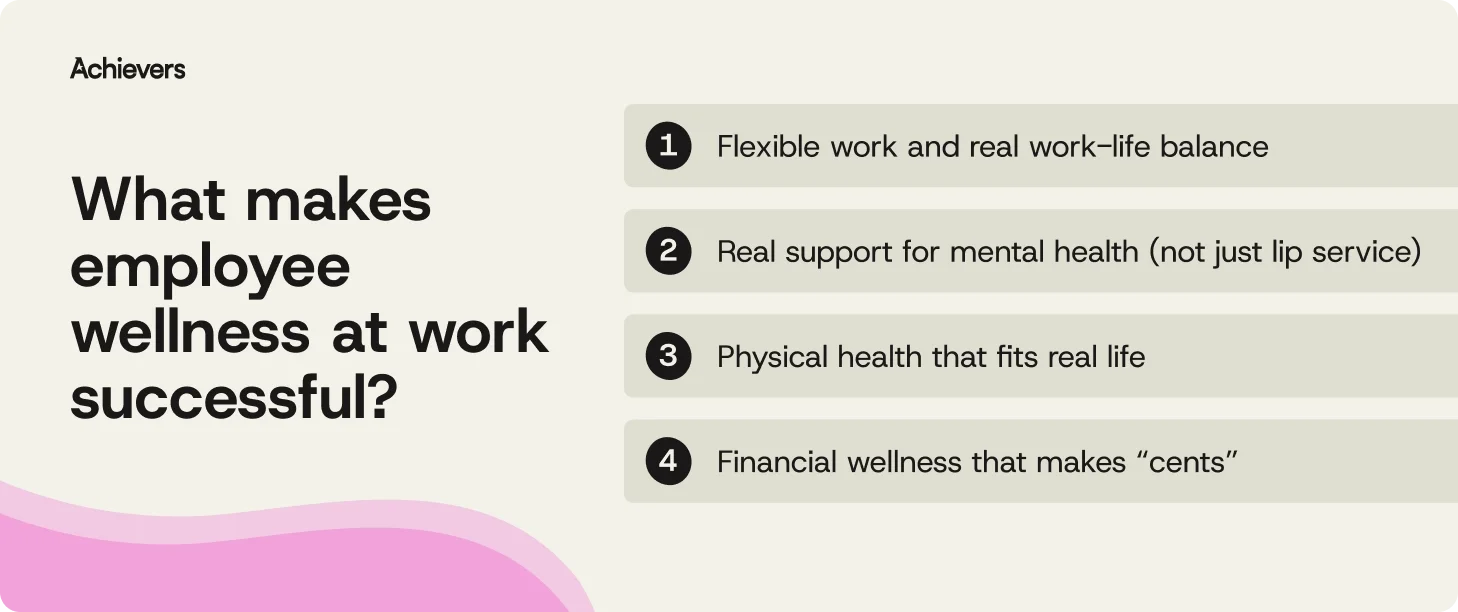Table of contents
Employee wellness programs aren’t just about good intentions — they’re about good business. When employees are stressed, burnt out, or disconnected, performance dips and absenteeism climbs. In fact, missed work can cost companies up to $3,600 per employee every year. That’s not a small line item.
The solution? Go beyond surface-level perks and focus on what actually drives healthier, more engaged teams: meaningful recognition and motivating rewards.
When employees feel seen and supported, their stress goes down, their motivation goes up, and their sense of belonging gets a serious boost. Recognition helps reinforce the behaviors that lead to better wellbeing — and better business results.
By integrating recognition into your wellness strategy, you create a culture that prioritizes people, encourages healthy habits, and builds long-term loyalty. But how? We’ll show you. Let’s explore four ways to elevate employee wellness by embedding recognition and rewards where they matter most.
What actually makes wellness work?
The best employee wellness programs don’t just tick boxes — they meet people where they are. That means thinking beyond step challenges and snack swaps to address the full picture: work-life balance, mental health, physical wellbeing, and financial wellness.
This could look like flexible work options, access to mental health support, or programs that help employees make sense of their money without making them feel like they missed a class in adulting. The goal? To create a culture where people feel genuinely supported — not just during crisis moments, but every day.
Up next: Four areas of wellness that matter most, plus practical ways to support your people in each — no yoga mats required.

1. Flexible work and real work-life balance
Let’s be honest: work-life balance isn’t about squeezing a dentist appointment into your lunch break. It’s about giving people the autonomy to do great work and live their lives — without having to apologize for either.
That’s where flexible work arrangements come in. They’re not perks — they’re foundational to a healthy, high-performing workforce. Here’s how to put them into practice:
- Remote and hybrid options: Cutting out the commute gives employees back precious hours (and their sanity). Letting people shape their workspace helps them focus, feel trusted, and stay engaged.
- Flexible scheduling: Whether they’re early birds or night owls, employees perform better when they can align their work with their energy. Flex hours help people be productive and present in their personal lives.
- Encouraging time off: PTO is only useful if people feel safe taking it. Normalize stepping away. Promote unplugged time. Make it clear that rest isn’t a reward — it’s a requirement.
- Parental leave and caregiver support: Life happens. Recognize the moments that matter by offering generous leave policies and caregiver support. It’s not just kind — it’s smart business.
- No-meeting days or focus hours: Give your team the gift of quiet. Setting aside time for deep work helps people stay on top of complex tasks without playing calendar Tetris.
Supporting flexibility isn’t just about logistics — it’s about trust. And trust, as it turns out, is a pretty great motivator.
2. Real support for mental health (not just lip service)
Let’s skip the stigma: mental health matters — to your people and your business. Stress, anxiety, and burnout don’t clock out at 5 p.m., so companies that proactively support mental wellbeing are the ones where people actually want to stay.
Here’s how to build mental health into your culture (without relying on vibes alone):
- Employee Assistance Programs (EAPs): Private, professional, and accessible — EAPs give employees a safe space to talk through life’s challenges, from anxiety and grief to “I have no idea how to adult right now.”
- Mental health days and stress management: Encourage people to take time off before they hit a wall. Pair that with wellness workshops and stress management resources, and you’re not just reacting to burnout — you’re helping prevent it.
- Manager training on mental health: A supportive company culture starts at the top. Equip managers to recognize the signs of struggle, respond with empathy, and steer employees toward the right support. Compassion is a leadership skill — and a competitive edge.
- Peer support and mindfulness programs: Safe spaces. No judgment. Mindfulness moments. These programs encourage employees to connect, decompress, and build resilience — together.
- Confidential digital resources: Whether it’s therapy on-the-go or a breathing app that actually helps, digital tools give employees discreet, on-demand access to care when they need it most.
Mental health support doesn’t have to be complicated — just consistent, compassionate, and part of your everyday culture. Your people (and your retention metrics) will thank you.
3. Physical health that fits real life
You don’t need a company-branded Fitbit to care about employee health (though it doesn’t hurt). Supporting physical wellbeing is about creating the kind of work environment where people can move, breathe, and feel good in their own bodies — whether they’re in the office or on the couch.
Here’s how to help your people stay energized and upright (literally):
- Fitness incentives and wellness programs: From gym memberships to lunchtime yoga or virtual fitness classes, offering flexible, inclusive ways to get moving helps employees prioritize their health without squeezing in a 5 a.m. workout.
- Ergonomic workplace design: Posture shouldn’t be a full-time job. Think adjustable chairs, standing desks, and accessories that make working feel less like a game of “where did that new neck pain come from?”
- Encouraging movement: Swap one meeting room for a walking route. Build in stretch breaks. Little nudges toward movement go a long way in breaking up sedentary slogs.
- Wellness challenges: A step challenge here, a hydration contest there — friendly competition not only supports physical health but brings people together. Bonus: you’ll finally know who takes the stairs on purpose.
- Healthy office environment: Stock the snack shelf with more than chips, add a few air-purifying plants, and make sure the space supports wellbeing from the ground up. You’d be amazed what a little natural light and clean air can do for morale.
Helping employees stay physically well isn’t about chasing six-packs or superfoods — it’s about enabling them to show up feeling good, every day. That’s when the real performance gains start to show.
4. Financial wellness that makes cents (pun intended)
Money stress doesn’t stay at home — it follows people to work, sits next to them in meetings, and quietly distracts them from doing their best. That’s why financial wellness is more than a benefit — it’s a business strategy.
Supporting employees with financial education and resources helps them feel more secure, more focused, and yes, more loyal. Here’s how to make it happen:
- Financial advisory services: Giving employees access to expert financial advice can demystify money management and boost confidence. Budgeting, investing, planning — it’s less overwhelming with a professional in their corner.
- Student loan and tuition assistance: Let’s be real: student debt is no joke. Helping employees pay it down (or continue their education) reduces financial pressure and shows you’re invested in their future — not just their current job title.
- Emergency savings programs: Life throws curveballs. Employer-sponsored savings options or low-interest emergency loans can help employees stay afloat without derailing their financial stability.
- Fair pay and transparency: Clear, competitive compensation isn’t just the right thing to do — it builds trust. Transparency around how pay is determined helps eliminate guesswork and reinforces a culture of fairness.
- Retirement planning support: Help employees prepare for the long game with resources, tools, and matching contributions that support a secure future. Because peace of mind shouldn’t stop at payday.
Financial wellbeing might not come up in every recognition moment — but when employees feel supported and secure, they’re more likely to bring their best selves to work. And that’s a win for everyone.
How Achievers helps bring wellness to life
Wellness initiatives work best when they’re embedded into the everyday employee experience — not treated like an optional side quest. That’s where Achievers comes in. By combining recognition, rewards, and real-time feedback, the Achievers platform helps organizations build wellness programs that feel natural, inclusive, and actually impactful.
- Recognition that motivates movement: When employees are recognized for prioritizing their wellbeing — whether it’s crushing a fitness goal or showing up for a mindfulness session — it sends a clear message: healthy habits matter. Public recognition turns wellness wins into culture-shaping moments, creating a ripple effect across teams.
- Rewards that reinforce healthy behaviors: With Achievers, you can offer rewards that align with wellness goals — like incentives for completing a step challenge or sticking to a new habit. It’s not bribery. It’s strategic encouragement, wrapped in appreciation.
- Feedback that fuels better programs: Preferences change. Needs evolve. With continuous feedback built into the platform, organizations can keep a real-time pulse on what’s working (and what’s not). That means wellness offerings stay relevant, inclusive, and aligned with your workforce — not just your wish list.
A culture of support, not just policy: At its core, Achievers helps build a recognition-rich environment where employees feel seen, valued, and supported — not just for their output, but for who they are. That sense of belonging? It’s the foundation of a truly well workplace.
Because when you shape a culture that celebrates wellness, you’re not just improving employee health — you’re strengthening your workforce from the inside out.
Wellness works better with recognition
Employee wellness isn’t just good for people — it’s great for business. When companies prioritize wellbeing, they see higher engagement, stronger retention, and fewer sick days. And when employees feel empowered to take care of themselves at work, they show up more focused, more motivated, and ready to make a real impact.
But here’s the thing: wellness doesn’t stick without reinforcement. That’s where recognition comes in.
With Achievers, recognition isn’t just a “nice job” — it’s a strategic tool that reinforces the healthy behaviors you want to see more of. From celebrating a completed step challenge to rewarding consistent participation in mental health programs, recognition turns one-time actions into ongoing habits.
By integrating Achievers into your wellness strategy, you get more than a platform — you get a proven way to shape culture and drive performance. With tools for social recognition, wellness-aligned rewards, and real-time feedback, HR leaders can build wellness programs that actually resonate (and get results).
Investing in wellness backed by recognition isn’t just thoughtful. It’s transformational. And it’s how the world’s best-run businesses keep their people — and performance — thriving.


